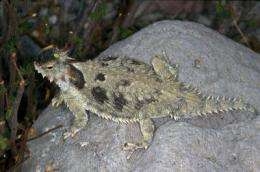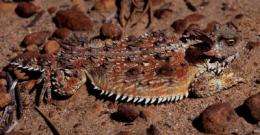For horned lizard, horns alone do not make the species

How do you recognize a new species? A thorough study of the million-year evolution of California's horned lizards, sometimes referred to as "horny toads," shows that when it comes to distinguishing such recently diverged species, the most powerful method integrates genetic, anatomical and ecological information.
In the study, published this week in the early online edition of the journal Proceedings of the National Academy of Sciences, researchers from the University of California, Berkeley, and the U.S. Geological Survey consider all these criteria to show that when the coast horned lizard (Phrynosoma coronatum) moved north from Baja California and spread throughout the state, it diverged into at least two new species.
"When you stack up all the data sets, they all support three species," said lead author Adam Leaché, a recent UC Berkeley Ph.D. recipient who is now a National Science Foundation bioinformatics postdoctoral fellow at UC Davis. "If you were to pick only one data set, you would get a different number of species. One lesson we learned about the speciation process is that you can't rely on one type of data to accurately track a species' history."
Aside from the oldest and original species, P. coronatum, found only in southern Baja California, the researchers identified a new species, P. cerroense, in central Baja and a third, P. blainvillii, whose range extends from northern Baja to Northern California. Within the third, wide-ranging species, the study's authors found enough genetic and ecological differences to suggest there are at least three distinct populations of P. blainvillii, each requiring separate management and protection.

The findings have implications for conservation efforts, because coast horned lizard populations are in decline from southern Baja California to Northern California due to several factors. Among these are loss of lowland habitat from agriculture and urbanization and the introduction of Argentine ants, which displace the more nutritious harvester ants, the favored diet of the lizards. The lizard is on the International Union for Conservation of Nature's Red List of Threatened Species, as are California's two other horned lizards, the desert and flat-tailed horned lizards.
"For decades, it has not been clear what might be useful conservation units within the declining horned lizards in coastal California. Our study finally gives some clarity and direction for conservation actions to follow," said co-author Robert Fisher, a research biologist at the U.S. Geological Survey in San Diego, Calif.
For over 100 years, scientists have been trying to distinguish species among coast horned lizards, with the number of recognized species ranging from 1 to 6 depending on the author. These prior studies were reliant almost entirely on morphology. But when it comes to recently diverged species like the coast horned lizard, where morphological differences are subtle, it can be difficult to distinguish species, according to co-author Jimmy McGuire, UC Berkeley associate professor of integrative biology.
"This sort of analysis is going to be necessary in order to tackle questions of recent speciation," McGuire said. "Lineages that have been separated for a long time are not controversial - we have no trouble distinguishing chimps from humans, for example - but it is trickier with species that are younger and thus less morphologically heterogeneous."
"This could have an impact on the number of species that we recognize on the planet, because many species are young like this," he added.
In particular, the number of species in California could be substantially underestimated because even well-studied groups like horned lizards are likely to be comprised of multiple cryptic species, McGuire said. Studies integrating diverse data sets and focusing on the question of gene flow between lineages will almost certainly result in the discovery of many new species, he added.
Over the course of millions of years, populations of horned lizards migrating northward have separated and diverged from one another, producing an array of genetic lineages all along the western coast of North America that are adapted to unique ecological niches, according to the study.
"The genetic differences between the populations of horned lizards in California are striking - nobody could have predicted this high degree of differentiation simply by looking at the physical differences between the lizards," Leaché said.
Given enough time and continued environmental protection for the lizards to persist for the long-term, it's likely that the California horned lizards, like those in Baja California, will also evolve more dramatic physical differences through natural selection.
Source: University of California - Berkeley (news : web)

















